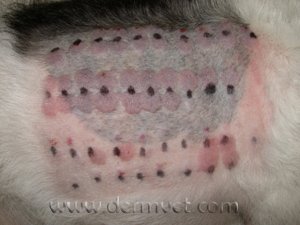Allergies | Treatments
Pets with allergies to pollen, grass, or dust are affected with atopic dermatitis or atopy. People with allergies have symptoms such as runny eyes and sneezing, but animals with allergies more commonly show symptoms such as scratching, licking of the feet, and recurrent skin and ear infections. These symptoms can occur only during certain seasons, if the main offending allergens are seasonal pollens, but can occur all year round if the allergens persist in the environment year-round (such as house dust mites and human dander). Atopic dermatitis typically starts in dogs between the ages of 6 months to 5 years and can occur at any time of life in cats.
In dogs, there is an increased incidence of allergies in certain breeds such as terriers, Cocker spaniels, Labradors, golden retrievers, Shar peis, and German shepherds, but any dog breed can be affected. The diagnosis of atopy is made by considering the symptoms, seasonality, and response to medications, and by ensuring no other similar itchy skin diseases such as food allergy, skin parasites, or skin infections are present. Once the clinical diagnosis of atopy has been made, the treatment options include treatment of allergic symptoms with topical and oral medications, or to perform allergy testing and desensitization injections to treat the underlying cause of the itching.
Symptomatic Allergy Treatment
-
Cyclosporin (brand name Atopica) is an oral medication which can be used as a non-steroid way to reduce allergic skin inflammation and itching. It is more expensive than steroids and is helpful in approximately 80% of allergic dogs to control itch. Cyclosporin is given orally daily for 4-6 weeks, then the dose and frequency is slowly decreased to the lowest possible dose needed for comfort (some dogs need it daily, and in some the dose can be reduced to every 2-3 days). Cyclosporin has fewer side effects than steroids, but because it is still an immunosuppressive drug (it is the same medication used to prevent organ transplant rejection in humans), regular physical examinations with bloodwork and urine testing should be performed in pets on long term treatment. Potential side effects include vomiting and diarrhea, and more rarely skin or internal infections and benign growths on the skin or gums.
-
Apoquel (chemical name oclacitinib) is an oral medication licensed for the treatment of both acute allergies and chronic atopy in dogs >12 months of age. It can be used instead of steroids to treat dogs with occasional seasonal pollen or flea allergy flares, and to control itch in allergic dogs while the underlying cause is addressed. This drug is a janus kinase inhibitor, similar to the human rheumatoid arthritis medication Xeljanz. Apoquel acts to reduce production of inflammatory allergic proteins and also to reduce the sensation of itch transmitted by nerves. It is intermediate in cost between steroids and cyclosporine and acts very rapidly (within hours) to reduce itching, but is less effective if skin or ear infections are present and can make infections worse. It appears so far to have very few side effects (occasional GI upset). Since this is a relatively new drug, and since it does affect the immune system, regular examinations and labwork are still recommended.
Non-steroidal immune modulators/ immunosuppressants
-
Fleas cause itching and hair loss due to the irritation caused by their bites, secondary bacterial infections, or to a flea bite allergy. Symptoms are often worse in warm weather when fleas are most numerous. Animals will often itch and lose hair on their back near their tail. Cats may also develop small crusts on their skin that are similar in appearance to tiny millet seeds (miliary dermatitis). In flea-allergic animals, even one fleabite can cause a reaction. With the availability of the effective veterinary prescription monthly flea treatment products, flea allergy has become easier to treat. Flea control in the home and yard is also important. Treatment of secondary bacterial skin infections and temporary anti-itch medication (steroids) are also often needed while the flea problem is being brought under control.
-
Demodex mites can cause patchy hair loss especially on the face and feet/legs) with only mild itching, or infected dogs can be very itchy if secondary bacterial infections develop. This mite is more common in puppies and immunosuppressed animals, and is not contagious to other pets or to people. Treatment options include oral antiparasite medications such as Bravecto, Nexgard, Simparica, weekly prescription antiparasitic dips, or daily oral antiparasitic prescription medications such as ivermectin or milbemycin. Skin scrapings are monitored monthly by the veterinarian to determine when it is safe to stop medication, and most dogs are treated for an average of 3-4 months. Herding breeds such as Collies, Shelties, Aussies, Border Collies and sheepdogs should not receive ivermectin due to risk of lethal toxicity, and all treatments should be prescribed and monitored by a veterinarian.
-
Scabies infection is very itchy and contagious to other dogs, and dogs may lose hair and be crusty on their ears and elbows. Scabies mites can be very difficult to find, and often we will trial-treat for scabies based on the dog’s symptoms and appearance, even if we cannot find mites on the skin scrapes. Treatment options for scabies mange include antiparasitic prescription medications such as Revolution spot on, or Bravecto and Nexgard chewable tablets; older treatment options include ivermectin or milbemycin given every 1- 2 weeks for 6 weeks or weekly prescription insecticidal dips for 4-6 weeks. With scabies, all dogs in the household must be treated at the same time, even if they are not showing signs yet, because some dogs can carry the mites and have no symptoms. Dogs with scabies may also have secondary bacterial or yeast skin infections which contribute to the itch. Again, herding breeds should not receive ivermectin due to risk of lethal toxicity, and all treatments should be prescribed and monitored by a veterinarian.




